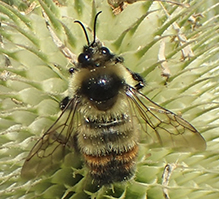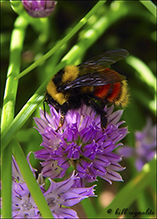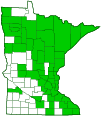red-belted bumble bee
(Bombus rufocinctus)
Conservation • Description • Habitat • Ecology • Distribution • Taxonomy
Conservation Status |
|
|||||||
| IUCN Red List | LC - Least Concern |
|||||||
| NatureServe | N4N5 - Apparently Secure to Secure |
|||||||
| Minnesota | not listed |
|||||||
Description |
||
The female (worker) bee is 7 ⁄16″ to ½″ long. The thorax and abdomen are densely covered with short hairs. The thorax is mostly yellow with a conspicuous black dot-shaped mark. Females have six abdominal segments. The first and fourth abdominal segments are yellow, the second and third are reddish, and the fifth and sixth are black. The head is black with a few light hairs above the antennae. The tongue is short. The queen is similar but longer and plumper. |
||
Size |
||
Queen: ⅝″ to 11 ⁄16″ Worker: 7 ⁄16″ to ½″ Male: ½″ |
||
Similar Species |
||
| Tricolored bumble bee (Bombus ternarius) has a black T-shaped mark, not a dot, on the thorax. | ||
Habitat |
||
|
||
Ecology |
||
Season |
||
June to September |
||
Behavior |
||
Bumble bees will sting to protect themselves or their nest. The stinger is not barbed and the bee can sting multiple times. |
||
Life Cycle |
||
The queen emerges from hibernation and searches for a new nesting site in May. |
||
Larva Food |
||
Larvae are fed both nectar for carbohydrates and pollen for protein. |
||
Adult Food |
||
Adults feed mostly on nectar but also on some pollen, especially flowers of clovers, sweet clovers, thistles, goldenrods, bonesets, and asters. |
||
Distribution |
||||
|
Sources |
|||
| 9/25/2022 | ||||
Occurrence |
||||
Frequently found |
||||
Taxonomy |
|||
Order |
Hymenoptera (Ants, Bees, Wasps, and Sawflies) | ||
Suborder |
Apocrita (Narrow-waisted Wasps, Ants, and Bees) | ||
Infraorder |
Aculeata (ants, bees, and stinging wasps) | ||
Superfamily |
Apoidea (bees and apoid wasps) | ||
| Epifamily | Anthophila (bees) | ||
Family |
Apidae (honey bees, bumble bees, and allies) | ||
Subfamily |
Apinae (honey, bumble, longhorn, orchid, and digger bees) | ||
Tribe |
Bombini | ||
Genus |
Bombus (bumble bees) | ||
| Subgenus | Cullumanobombus | ||
Some authors separate bumble bees and orchid bees into the subfamily Bombinae. NCBI follows this classification. Most authors follow Michener (2007) and include those groups in the subfamily Apinae with the honey bees. |
|||
Synonyms |
|||
|
|||
Common Names |
|||
red-belted bumble bee |
|||
Minnesota Bumble Bee Identification Guide
The University of MN Bee Lab has a free field identification guide to Minnesota bumble bees. It is indispensable for amateur naturalists or anyone wanting to identify the bumble bee in their photo. Click on the image below to download the guide.
Visitor Photos |
|||||
Share your photo of this insect. |
|||||
| This button not working for you? Simply email us at info@MinnesotaSeasons.com. Attach one or more photos and, if you like, a caption. |
|||||
Babette Kis |
|||||
Bombus rufocinctus red belted bumblebee Bombus rufocinctus red belted bumblebee on common teasel Racine Co. WI, weedy area of Barnes Prairie |
 |
||||
Bill Reynolds |
|||||
| This is Bumble I see quite often here in Minnesota. The flower is a chive growing in my garden. |  |
||||
MinnesotaSeasons.com Photos |
|||||
|
|||||

Slideshows |
||

Visitor Videos |
|||
Share your video of this insect. |
|||
| This button not working for you? Simply email us at info@MinnesotaSeasons.com. Attach a video, a YouTube link, or a cloud storage link. |
|||
Other Videos |
|||


Last Updated:



